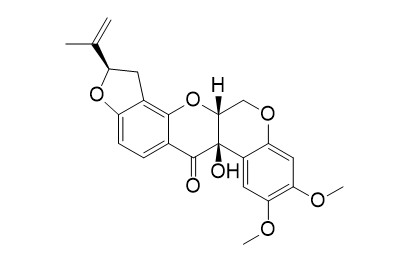12-alpha-Hydroxyrotenone
Rotenolone(12-alpha-Hydroxyrotenone) is the main metabolite of rotenone and has high insecticidal and fishicidal activities.
Inquire / Order:
manager@chemfaces.com
Technical Inquiries:
service@chemfaces.com
Tel:
+86-27-84237783
Fax:
+86-27-84254680
Address:
1 Building, No. 83, CheCheng Rd., Wuhan Economic and Technological Development Zone, Wuhan, Hubei 430056, PRC
Providing storage is as stated on the product vial and the vial is kept tightly sealed, the product can be stored for up to
24 months(2-8C).
Wherever possible, you should prepare and use solutions on the same day. However, if you need to make up stock solutions in advance, we recommend that you store the solution as aliquots in tightly sealed vials at -20C. Generally, these will be useable for up to two weeks. Before use, and prior to opening the vial we recommend that you allow your product to equilibrate to room temperature for at least 1 hour.
Need more advice on solubility, usage and handling? Please email to: service@chemfaces.com
The packaging of the product may have turned upside down during transportation, resulting in the natural compounds adhering to the neck or cap of the vial. take the vial out of its packaging and gently shake to let the compounds fall to the bottom of the vial. for liquid products, centrifuge at 200-500 RPM to gather the liquid at the bottom of the vial. try to avoid loss or contamination during handling.
Methods Protoc.2024, 7(6):95.
BMC Complement Altern Med.2019, 19(1):339
Biomedicines.2022, 10(3):583.
Korean J. Medicinal Crop Sci.2023, 31(6):388-395.
Front Pharmacol.2023, 14:1244655.
Phytomedicine.2021, 83:153483.
Industrial Crops and Products2021, 163:113313.
Evid Based Complement Alternat Med.2020, 2020:1970349.
Horticulturae2023, 9(2), 213.
Photodermatol Photoimmunol Photomed.2024, 40(1):e12950.
Related and Featured Products
Chemosphere . 2022 Feb;288(Pt 2):132478.
Field and laboratory characterization of rotenone attenuation in eight lakes of the Kenai Peninsula, Alaska[Pubmed:
34626650]
Rotenone is a pesticide commonly used to eradicate Northern Pike (Esox lucius), an invasive species, in Southcentral Alaska. The present work incorporates a field investigation of rotenone attenuation in eight lakes of the Kenai Peninsula, following a CFT Legumine® treatment in October 2018 and a laboratory simulation to determine persistence under light/dark and sterile/nonsterile conditions representative of Southcentral Alaskan winters. In the field, rotenone degraded within <60 days of application in all lakes, while rotenolone, the primary product of rotenone degradation, persisted for up to <280 days post-treatment at two locations. Prolonged rotenolone attenuation was most likely caused by short days and ice cover between October and April. This hypothesis was supported by a laboratory simulation which revealed photolysis as the dominant process driving the overall degradation of rotenone and that microbial degradation will significantly contribute in the absence of sunlight under simulated "winter" conditions of 4 °C. Degradation model fit comparisons (pseudo-first order, multi-parameter linear, and gamma) indicate the most accurate prediction occurred when modeling all eight lakes grouped together in a single dataset, combined and treated with pseudo-first order model kinetics, based on Akaike information criteria (AIC) scores.
Environ Toxicol Chem . 2012 May;31(5):1032-1041.
Rotenone formulation fate in Lake Davis following the 2007 treatment[Pubmed:
22407799]
In September 2007, Lake Davis (near Portola, California) was treated by the California Department of Fish and Game with CFT Legumine, a rotenone formulation, to eradicate the invasive northern pike (Esox lucius). The objective of this report is to describe the fate of the five major formulation constituents-rotenone, rotenolone, methyl pyrrolidone (MP), diethylene glycol monethyl ether (DEGEE), and Fennedefo 99-in water, sediment, and brown bullhead catfish (Ameiurus nebulosus; a rotenone-resistant species) by determination of their half-lives (t(1/2)) and pseudo first-order dissipation rate constants (k). The respective t(1/2) values in water for rotenone, rotenolone, MP, DEGEE, and Fennedefo 99 were 5.6, 11.1, 4.6, 7.7, and 13.5 d; in sediments they were 31.1, 31.8, 10.0, not able to calculate, and 48.5 d; and in tissues were 6.1, 12.7, 3.7, 3.2, and 10.4 d, respectively. Components possessing low water solubility values (rotenone and rotenolone) persisted longer in sediments (not detectable after 157 d) and tissues (<212 d) compared with water, whereas the water-miscible components (MP and DEGEE) dissipated more quickly from all matrices, except for Fennedefo 99, which was the most persistent in water (83 d). None of the constituents was found to bioaccumulate in tissues as a result of treatment. In essence, the physicochemical properties of the chemical constituents effectively dictated their fate in the lake following treatment.
Chromatographia . 2021 Feb;84(2):207-214.
Identification of Rotenone and Five Rotenoids in CFT Legumine Piscicide Formulation via High Resolution Mass Spectrometry and a New High-Throughput Extraction Procedure[Pubmed:
33776066]
The piscicide CFT Legumine is applied to freshwater systems around the world to control invasive fish species. Rotenone, a potent inhibitor of mitochondrial cellular respiration, is the active ingredient of the piscicide; however, other rotenoids of unknown persistence and toxicity account for an equivalent amount by weight. This work identified six distinct rotenoids in CFT Legumine using liquid chromatography coupled with high resolution orbitrap mass spectrometry and optimized a rapid surface water sampling procedure for their analysis. The rotenoids were identified as rotenone and its isomer deguelin, their 12α-hydroxylated products rotenolone and tephrosin, as well as 6α,12α-dehydrorotenone and 6α,12α-dehydrodeguelin. The optimized procedure, extraction with Spin-X nylon membrane microcentrifuge filters followed by elution with acetonitrile, achieved recoveries ranging from 101 - 107 % and 97 - 145 % for all six rotenoids at high (125 nM, ~50 ppb) and low (25 nM, ~10 ppb) concentrations of CFT Legumine, respectively. Overall, this method provides a rapid sampling procedure necessary for monitoring rotenoid persistence in surface water to ensure safe and efficacious application of the pesticide.



